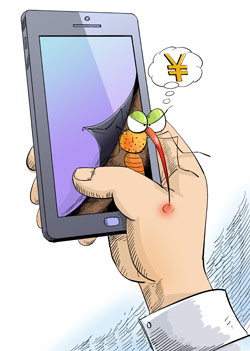Chinese smartphone users face increasing threats from malicious applications as a rising number of applications designed to hack the phones' operating systems have poured into the market over the past two months, said an industry report.
The amount of malware surged in May and June, according to a half-year mobile Internet safety report released by NQ Mobile Inc, China's largest mobile security provider by user number.
 |
|
The amount of malware surged in May and June. Nearly 3.7 million smartphones were attacked by malicious apps in June, the highest number ever recorded, according to a half-year mobile Internet safety report released by NQ Mobile Inc, China's largest mobile security provider by user number. [Photo/China Daily] |
More than 10,000 apps designed to hack smartphones were detected as of June. There were fewer than 2,000 detected in April.
Nearly 3.7 million smartphones were attacked by malicious apps in June, the highest number ever recorded.
Smartphones running the Android system were the biggest victims. A total of 3 million Android phones were attacked last month, according to the report, adding that the number of attacks against the world's most used open-source operating system jumped by 62 percent in the first six months of this year compared with the second half of 2011. The infection rate of smartphones running the Android system hit 78 percent in June. The figure was 40 percent at the end of last year.
Nokia Corp's Symbian was the second-biggest target for malicious software, with fewer than 500,000 new infections each month, far lower than Android's figures. However, the disparity is not because Symbian users have better malware protectionian, letting its user numbers decline.
"A great number of apps started to shift from Symbian to Android because fewer people are buying smartphones running it, while the user numbers of the Android system keep growing," said the report.
The Android system had nearly 70 percent of the market share in China by the end of last year.
In addition, the Chinese mainland has become the hardest-hit area globally. The number of infected smartphones in China took more than a quarter of the world's total.
The infection rate was actually the highest worldwide, followed by Russia, the United States and India, where each country took more than 15 percent of the global infections.
"The large number of third-party online app stores provide an easy download platform for apps made for insidious purposes," said Shi Wenyong, co-founder and chief operating officer of NQ Mobile. He added that a disreputable underground profit chain has been forged over the years.
"From programming, spreading to user fee deductions, all kinds of jobs were assigned to different interest groups. Their teamwork poses a serious security threat to smartphone users."
The spread of malicious apps seams to have a direct correlation with a a region's economic development level. Smartphone users in the nation's coastal regions are more at risk than users inland.
South China's Guangdong province is suffering the worst safety situation across the country, followed by Jiangsu, Beijing, Sichuan and Fujian, said the report.
Security engineers warned that mobile phone payments - an online funds transfer service which is frequently used in economically developed regions - could become the next victim of bad apps.
gaoyuan@chinadaily.com.cn
